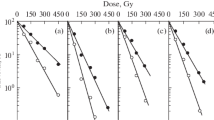Abstract
The induction of moderate levels of methaemoglobin by 4-dimethylaminophenol (DMAP) was studied in human and dog blood in vitro and in dogs in vivo. Although the rate of formation of methaemoglobin following intravenous injection into dogs was similar to that following addition of DMAP to dog blood in vitro, in the latter case levels fell more slowly. Addition of DMAP at the same concentrations in vitro resulted in more rapid oxidation of haemoglobin and higher peak levels of methaemoglobin in dog blood than in human blood. It was concluded that the rate of formation of methaemoglobin as well as the activity of methaemoglobin reductase must be considered when extrapolating data from the dog to man.
Similar content being viewed by others
References
Agar NS, Harley JD (1972) Erythrocytic methaemoglobin reductases of various mammalian species. Experientia 28: 1248–1249
Bastian G, Mercker H (1959) Zur Frage der Zweckmäßigkeit der Inhalation von Amylnitrit in der Behandlung der Cyanidvergiftung. Naunyn-Schmiedebergs Arch Exp Pathol Pharmacol 237: 285–295
Chen KK, Rose CL, Clowes GHA (1934) Comparative values of several antidotes in cyanide poisoining. Am J Med Sci 188: 767–771
Evelyn RA, Malloy HT (1938) Microdetermination of oxyhemoglobin, methemoglobin and sulfhemoglobin in a single sample of blood. J Biol Chem 126: 655–662
Ivankovich AD, Braverman B, Kanura RP, Heyman HJ, Paullisian R (1980) Cyanide antidotes and methods of their administration in dogs: A comparative study. Anesthesiology 52: 210–216
Jandorf BJ, Bodansky O (1946) Therapeutic and prophylactic effect of methemoglobinaemia in inhalation poisoning by hydrogen cyanide and cyanogen chloride. J Ind Hyg Toxicol 128: 215–133
Kiese M, Weger N (1965) The treatment of experimental cyanide poisoning by hemiglobin formation. Arch Toxicol (Berl) 21: 89–100
Kiese M, Weger N (1969) Formation of ferrihaemoglobin with aminophenols in the human for the treatment of cyanide poisoning. Eur J Pharmacol 7: 97–105
Kiese M, Weis B (1943) Die Reduktion des Hämoglobins in den Erythrocyten verschiedener Tiere. Naunyn-Schmiedebergs Arch Exp Pathol Pharmacol 202: 493–501
Mladoveanu C, Gheorghiu P (1929) Le nitrite de soude comme antidote de l'empoisonnement expérimentale par le cyanure de potassium. CR Soc Biol (Paris) 102: 164–166
Paulet G (1954) Sur le valeur du nitrite d'amyle dans le traitement de l'intoxication cyanhydrique. CR Soc Biol (Paris) 148: 1009–1014
Perdigo M (1888) Antagonism between amyl nitrite and prussic acid. Tr Med Soc Virginia 19: 124
Robin H, Harley JD (1966) Factors influencing response of mammalian species to the methemoglobin reduction test. Aust J Exp Biol Med Sci 44: 519–526
Sekiya M, Tomie M, Nelson L (1968) Dealkylation of aromatic tertiary amines with formates. J Org Chem 33: 318–322
Tinker JH, Michenfelder JD (1976) Sodium nitroprusside: Pharmacology, toxicology and therapeutics. Anesthesiology 45: 340–354
Weger N (1977) Antidote bei akuten Vergiftungen. Fortschr Med 95: 2409–2412
Weiss S, Elliss LB (1933) Influence of sodium nitrite on cardiovascular system and renal activity in health, in arterial hypertension and in renal disease. Arch Intern Med 52: 105–119
Author information
Authors and Affiliations
Rights and permissions
About this article
Cite this article
Bright, J.E., Marrs, T.C. A model for the induction of moderate levels of methaemoglobinaemia in man using 4-dimethylaminophenol. Arch Toxicol 50, 57–64 (1982). https://doi.org/10.1007/BF00569237
Received:
Issue Date:
DOI: https://doi.org/10.1007/BF00569237




